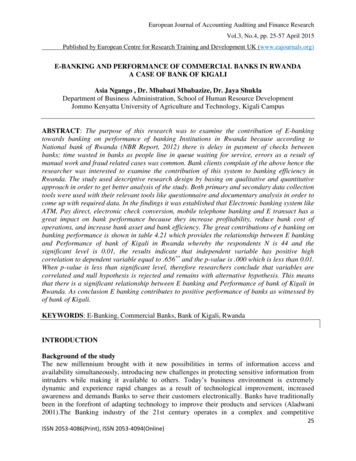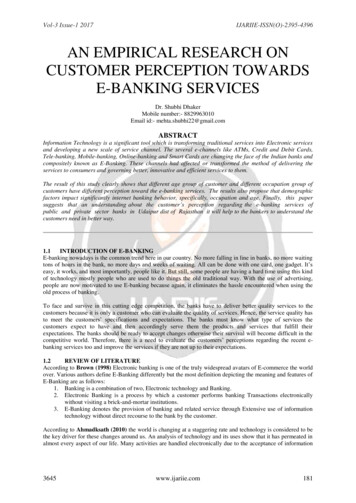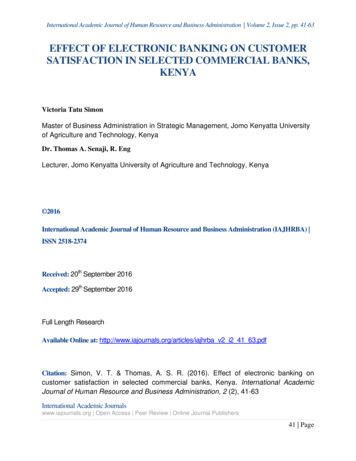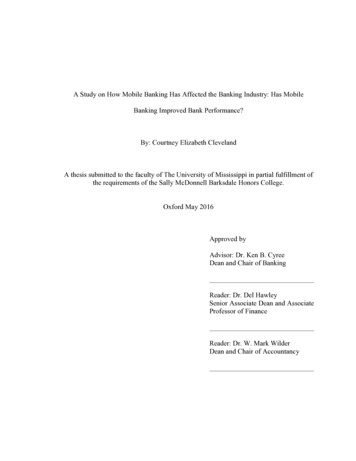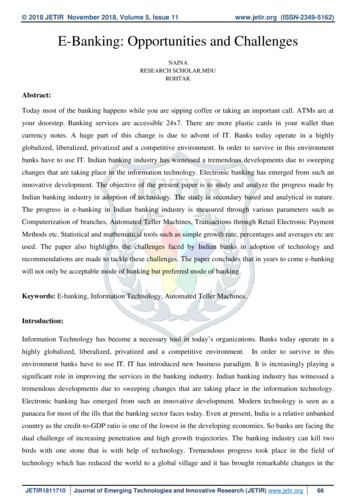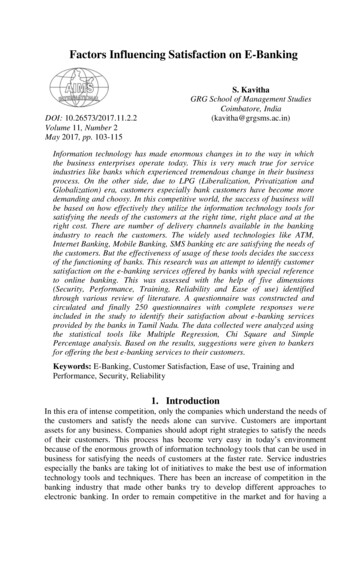
Transcription
Banking Risk & Regulatory Academy2021 December
6-10 December 20215 W E B I N A RSDAY1 6-DEC, 10:00-11:00 CETWhat’s new on the regulatory andsupervisory agenda?DAY2 7-DEC, 10:00-11:00 CETLiving with CRR3How the new rules will affect bankingDAY3 8-DEC, 10:00-11:00 CETHow to prepare for the 2022 ECBClimate Risk Stress Test?18SUBJECT MATTEREXPERTS9COUNTRIESfrom Central and Western 4 9-DEC, 10:00-11:00 CETDigital transformation in credit processDAY5 10-DEC, 10:00-11:00 CETTransfer pricing and the digitalbanking business modelLuxembourgPolandRomania 2021 Deloitte Central Europe1
DAY 2Living with CRR3How the new rules will affect banking 2021DeloitteDeloitte Central Europe 2021Risk & Regulatory Academy22
AgendaCRR III/CRD VI Overview1The Output Floor2Standardized vs Internal RatingsBased Approach3Potential business impactsof the Banking Package 20214Michael CluseRisk Advisory Director,Deloitte GermanyJean Philippe PetersNorbert GruberRisk Advisory Leader,Deloitte LuxembourgRisk Advisory Director,Deloitte AustriaHerve PhaureCredit Risk Leader,Deloitte France 2021 Deloitte3
CRR III/CRD VI Overview
Overview of the new Banking Package and the Regulatory RoadmapThe implementation of „Basel IV“ via the new CRR III shall increase the resilience of the banking sector and improve thetransparency and comparability of capital requirements.Basel III vs. Basel IVBanking Package 2021Commission ProposalBasel IIIOwn FundsCET 1AT 1On 27 October 2021 the EU Commissionpresented a proposal to implement the„Basel IV“ accord in the European Union.Tier 2The package includes changes to CRR and CRD.In addition there are a few changes with aview to recovery and resolution.RWA (Risk Weighted Assets)The modified CRR will be directly applicable.The new rules shall be binding from January2025 onwards.Basel IVOutput FloorCredit RiskCRSAIRBACVASA-CCRCRR IIISec.MarketRisk/FRTBOpRiskCRD VI 2021 Deloitte Central Europe5
Overview of the new Banking Package and the Regulatory RoadmapKnown and expected timeline for Consultation and ImplementationPublication ofBCBS #424(“Basel IV“ )2018First DraftCRR III and CRD VIby EU Commission“Basel IV“applicable(acc. to BCBS)202220212023CRR III applicable(acc. to proposal)finalOutputFloor Level20252030Commission, Council, ParliamentEU Legislation„Trilogue“: Political negotiations areexpected to last approximately two years.CRR IIICredit risk (SA and IRB) CVA OpRisk Output Floor FRTB (binding capital requirements)Legislativeproposal delayedbecause ofCOVID-19Applicable(according to commission)from 1. January 2025CRD VI*SREP ESG Fit & Proper Third Country Branches End of legislative processnot before 2023BANKTransposition in national law (time frame not yet clear)* CRD VI includes a number of new regulatory requirementsthat are not directly derived from the Basel accord. 2021 Deloitte Central Europe6
The European Commission's CRD VI/CRR III proposalKeyDerived from Basel accordInitiatives contained in the amendments to the Regulation and the DirectiveNot derived from Basel accordMandate to publish report onlyCRR IIICRD VIAmending Directive 2013/36/EUAmending Regulation 575/2013SA Credit RiskMarket RiskIRB Credit RiskCVA RiskOutput FloorOperational RiskCredit Risk MitigationLeverage RatioMarket RiskESGCIUsReporting/DisclosureMinimum Haircut Floorsfor SFTsCrypto Assets 2021 Deloitte Central EuropeSupervisory PowersOutput Floor Adjustments(P2R/SyRB)Independence of CAsESGFit & ProperFOLTF/AuthorisationThird Country BranchesAdministrativeSanctioning RegimePillar 2 CompositionSupervisory Benchmarking ofOwn Funds Calculation7
CRR IIIFor the various areas of regulation included in CRR III, different implications* can be derivedRWA ImplicationsLegislative ProposalEU SpecificsStrategyImplementationKSAIRBACVAOpRisk* The implications shown on this pagedemonstrate the complexity ofCRR IIII for a typical/average bank,based on a first analysis. A moredetailed analysis must be based onan individual assessment of eachbank. 2021 Deloitte Central Europe?OutputFloorLegend:The impact per area is expected to bevery lowlow,medium,high,very high.8
The Output Floor
Capital Floor MechanismAn aggregated Capital Floor of 72.5% limits the capital savings through the use of Internal ModelsI M P L E M E N TAT I O NCapital FloorRegulationComparison of total RWAunder consideration ofapproved Internal Modelswith the respectiveStandardized Approaches( implicit compensation)Limitation through aCapital Floor of 72.5%based on total RWA usingthe respective StandardizedApproachesTransitional arrangementsto mitigate the effects 2021 Deloitte Central Europe100Floor: 72.5%80Additional CapitalRequirements6040200RWA according to StandardizedApproaches (S-TREA)RWA according to InternalModels (U-TREA) Sum of RWA of Sum of RWA of Credit Risk Standardized Approach (CRSA) SA-CCR BA-CVA/SA-CVA/100% RWAcounterparty risk* SEC-ERBA/SEC-SA/1250%* Standardized Approach forMarket Risk The regulatory approvedInternal Models The standardised approachesfor all portfolios/risk types thatare not treated according toInternal ModelsTREA Total risk exposure amount Standardised Measurement Approach forOperational Risk10
Capital Floor MechanismAn aggregated Capital Floor of 72.5% limits the capital savings through the use of Internal ModelsI M P L E M E N TAT I O NCapital FloorRegulationCredit Risk (incl. Sec)Introduction forPillar I: Minimumrequirements basedon new regulationsCCRCVAComparison of total RWAunder consideration ofapproved Internal Modelswith the respectiveStandardized Approaches( implicit compensation)Full implementationMarket riskOpRisk2025Limitation through aCapital Floor of 72.5%based on total RWA usingthe respective StandardizedApproaches2026202720282029Increase at the beginning of every year203072.5%70%65%60%55%Capital Floor50%Transitional arrangementsto mitigate the effectsTransitional period shall give institutions time to adjust their capital base or portfolios to the new conditions 2021 Deloitte Central Europe11
The Output FloorThe proposals for CRR III/CRD VI provide details on how to implement the Output Floor§Scope of applicationAdditional phase-in/transition rules under CRR III Output floor applies on top consolidated level only( group or stand-alone entity)Until end of 2029 the additional capital requirements arelimited to 25% of the unfloored Total Risk Exposure Amount(U-TREA), supplementing the floor phase-in ( 125% rule) Groups with non-EU parent institution:Application on consolidated level of EU group In case of groups operating in different EU member statesthe total floor will be distributed among entities/subconsolidated groups per member state (based onindividual share)Avoidance of double counting When the floor “bites”, the P2R/SyRB capital requirementsshall be “frozen” to avoid purely arithmetic increase In this case the NCA must review the calibration ofP2R/SyRB. Only after re-calibration the new requirementsapply 2021 Deloitte Central EuropeFor some exposure types IRB banks can use a preferential riskweight when calculating the standardised TREA (subject tonational discretion): Corporate Exposures:RW of 65% for unrated corporates with PD 0,5%Transition rule until end of 2032 Residential real estate (secured part)Up to 55% of property value: Risk weight 10%Up to 80% of property value: Risk weight 45%Transition rule until end of 2029 Residential real estate (unsecured part)Risk weight 2030: 52.5%Risk weight 2031: 60%Risk weight 2032: 675%Reversal from IRBA to CRSA is possible in 2025–2027under certain circumstances ( no regulatory arbitrage),unless the NCA objects12
The effect of the Capital FloorAs soon as the floor „bites“, only the standardised approach mattersSA RWAOutputFloorThe Output Floor bites: An example for the marginal/effective RWA changes including the capital floor requirementsIaExamplePortfolio1 Portfolio : RWSA RWIMSum2 Portfolio : RWSA RWIMSum3 Portfolio : RWSA RWIMSum4 Portfolio : RWSA RWIMSumaIM .000651.500- 1.000- 1.000999.000649.000- 1.500- 1.000998.500649.000EAD * RWSA1.001.0001.000100%150%1.001.000- 1.000100%100%999.000- 1.000150%100%999.000As soon/as long as the Floor “bites”, the total RWA is equal to EAD * RWSA * Floor factor.As a result, only the SA is relevant for portfolio management. IM serves as proof, that the bankis entitled to a discount of (1-Floor factor) in relation to RWSA. Impact is most severe for thoseportfolios where the risk (weight) is relatively low. 2021 Deloitte Central EuropeFloor LevelIMb725.000Floor ImpactbΔ RWAeffΔ Floor75.000Check(Δ RWAeff – Δ Floor )RWASA* Floor factor725.72575.225725225500725.72574.225725- 7751.500724.27575.275- 725275- 1.000723.91374.913- 1.088- 88- 1.000Check: Δ RWAIM Δ RWAeff – Δ Floor resp. Δ RWAeff ΔRWAIM – Δ FloorAny difference between (RWSA * Floor Level) and RWIM will be absorbed by the capital floor.13
Standardized vs InternalRatings Based Approach
The new co-existence of the Standardized and Internal Ratings Based ApproachThe EU‘s 2021 Banking Package includes two crucial amendments in the area of IRB application requirementsSELECTIVE IRB ROLL-OUTPOTENTIAL REVERSAL TO STASelective Application of IRBATransitional Arrangements Adoption of IRB does no long require banks to implement theIRB approach for alle exposures or minimum coverage ratiosPermanent partial use exemption has been abolishedaccordinglyGoing forward under CRR III, institutions can implement IRBapproach for only one or selected exposures classes (withouthaving to adhere to Permanent Partial Use provisions)Art 148 and Art 150 CRR III To ensure a level playing field, IRB-banks are allowed to revertIRB portfolios back to Standardized approachThe reversal is possible within a three year transitional periodand subject to competent authorities‘ approval under asimplified procedureTransitional period: 01 January 2025 – 31 December 2027Art 494d CRR IIIThe new IRBA application provisions allow for a more selective IRB application, thereby providing institutions with an increased degree offlexibility regarding the choice of their credit risk approach.Deloitte 202115
Comparative studies suggest RWA savings for IRB portfolios also under Basel IV rulesThe gap between Standardized and IRB RWAs has been reduced based on the new rules, but is still substantialØ RW under STAØ RW under IRBDeltasSelected Exposure ClassesCRRBasel IVCRRBasel IVCRR / Basel IVCorporates (SME)95%85%45%45%50% / 40%Corporates88%84%52%50%36% / 34%Retail73%75%31%34%42% / 41%Secured by Real Estate (RRE/CRE)42%50%14%16%28% / 34%BCBS (2020): Basel III Monitoring Report, April 2020 (Group 2 Institutions), Deloitte Analyses.Implications of IRB and Basel IV The results are based on Basel IV rules and not on CRR III rules. The results of the aggregated analyses only allow for a rough estimate of the RWADeloitte 2021effects. This is due to differences in the individual calculation assumptions as wellas individual portfolio and customer structures causing distortions.16
The new co-existence of the Standardized and Internal Ratings Based ApproachThe EU‘s 2021 Banking Package includes two crucial amendments in the area of IRB application requirementsIRB-BENEFITSIRB-COSTSInitial IRB ApprovalIncreased risk-sensitivity in Pillar I RWA calculation and cost savings Consistency in Pillar I/II management and integration Improved risk managementSimplified IRB approval for previous use of IRB-eligible (pool) modelsin Pillar IIBased on the new CRR III rules, the potential benefits and costs of theIRB approach should be (re-)assessed in the context of a preliminarystudy; reversal deadlines and lengthy application processes require atimely preparation.Deloitte 2021Efforts for establishing "IRB readiness", considering minimum regulatoryrequirementsCosts of the regulatory approval processInitial IRB Approval Ongoing efforts to comply with minimum IRB requirements, including:-Independent model validations & testingModel enhancements and significant model change reviews/auditsIncreased discipline throughout the entire credit processThe IRB approach should not be considered as a pure instrument todecrease capital requirements but should rather be motivated by theadvantages resulting from an increased risk-sensitive management inPillar I and the subsequent integration between Pillars I and II.17
Potential business impactsof the Banking Package2021
Potential business impacts of the Banking Package 2021Banks will need to assess what all these new measures mean to them in terms of business and risk strategy, yet someinitial trends can already be identified Supporting furtherspecializationDriving reorganization ofEU activities for thirdcountry groups Fast tracking ESGtransition Reconsideringperformancemeasurement metrics 2021 Deloitte Central Europe The proposed reform is expected to lead to a weighted average increase in EU banks’ minimum capital requirements of 6.4% to 8.4% in the long term (by 2030) after the envisaged transitional period – but with very large discrepanciesbetween bank types.Some activities such as mortgage lending, corporate lending, equity investment and specialized lending (incl. infrastructureprojects financing) are materially amended and could push banks to reconsider their portfolios mix and pricing strategy.Some third country groups hold 2/3 of their assets in the EU in branches (TCBs) rather than EU legal entities.Strengthened regime introduced to increase supervisory power of the ECB on TCBs (all subject to (re-)authorisationrequirement) and to promote further harmonization on how they are monitored and treated.Capital endowment and liquidity requirements are introduced (with proportionality), as well as the power to subsidiariesunder some conditions.New measures should provide sufficient regulatory incentives for EU banks to accelerate their role as a sustainable source offinance (public disclosures for all banks, inclusion in ICAAP/SREP, positive impact of energy efficiency lending for mortgage,etc.).This could be the first steps towards more stringent prudential treatment of assets exposed to ESG risks that will beproposed by the EBA by June 2023 (e.g. specific risk weights for particularly high exposure to climate risk)Banks increasingly face challenges in designing appropriate internal performance measures with the different and sometimescontradictory concepts used in prudential regulation.For instance, regulatory capital requirements are based on a one-year time horizon while increasingly important elementssuch as IFRS 9 or climate risk relate to much longer time horizon (beyond 10 years) – creating difficulties to design andcalibrate indicators and metrics to align long term objectives (incl. sustainability related) with short term considerations tooptimize capital consumption.19
Deloitte refers to one or more of Deloitte Touche Tohmatsu Limited (“DTTL”), its global network of member firms, and their related entities (collectively, the “Deloitte organization”). DTTL (also referred to as“Deloitte Global”) and each of its member firms and related entities are legally separate and independent entities, which cannot obligate or bind each other in respect of third parties. DTTL and each DTTLmember firm and related entity is liable only for its own acts and omissions, and not those of each other. DTTL does not provide services to clients. Please see www.deloitte.com/about to learn more.Deloitte Central Europe is a regional organization of entities organized under the umbrella of Deloitte Central Europe Holdings Limited, the member firm in Central Europe of Deloitte Touche Tohmatsu Limited.Services are provided by the subsidiaries and affiliates of, and firms associated with Deloitte Central Europe Holdings Limited, which are separate and independent legal entities. The subsidiaries and affiliates of,and firms associated with Deloitte Central Europe Holdings Limited are among the region’s leading professional services firms, providing services through nearly 7,000 people in 44 offices in 18 countries.This communication contains general information only, and none of Deloitte Touche Tohmatsu Limited („DTTL“), its global network of member firms or their related entities (collectively, the “Deloitteorganization”) is, by means of this communication, rendering professional advice or services. Before making any decision or taking any action that may affect your finances or your business, you should consult aqualified professional adviser.No representations, warranties or undertakings (express or implied) are given as to the accuracy or completeness of the information in this communication, and none of DTTL, its member firms, related entities,employees or agents shall be liable or responsible for any loss or damage whatsoever arising directly or indirectly in connection with any person relying on this communication. DTTL and each of its memberfirms, and their related entities, are legally separate and independent entities. 2021. For information, contact Deloitte Central EuropeRisk & Regulatory Academy
Transposition in national law (time frame not yet clear) . Art 148 and Art 150 CRR III Art 494d CRR III. Deloitte 2021 16 The gap between Standardized and IRB RWAs has been reduced based on the new rules, but is still substantial Comparative studies suggest RWA savings for IRB portfolios also under Basel IV rules BCBS (2020): Basel III Monitoring Report, April 2020 (Group 2 Institutions .
